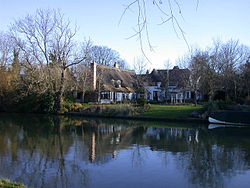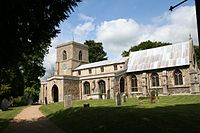Fen Ditton
| Fen Ditton | |
| Cambridgeshire | |
|---|---|
 Thatched cottages at Fen Ditton, from across the Cam | |
| Location | |
| Grid reference: | TL485602 |
| Location: | 52°13’12"N, -0°10’12"E |
| Data | |
| Population: | 747 (2001) |
| Post town: | Cambridge |
| Postcode: | CB5 8 |
| Dialling code: | 01223 |
| Local Government | |
| Council: | South Cambridgeshire |
| Website: | fenditton.org |
Fen Ditton is a village in Cambridgeshire, beyond the north-east edge of Cambridge. The parish covers an area of roughly two square miles. The scenic path along the Cam’s south bank runs through the luxuriant grass of Coldham's Common for miles to reach Fen Ditton.
Fen Ditton lies on the east bank of the River Cam, on the road from Cambridge to Clayhithe, and close to junction 34 of the A14. The nearest railway station is Cambridge, though Waterbeach Station is just north of the village.
History
The site has been occupied since at least the Neolithic Age, and stone tools have been found on the meadows between the village and the river.
The name was first recorded in around 950 as Dittone, meaning "the village by the ditch", derived from the Fleam Dyke, the prehistoric ditch that passed through the village from the river to the edge of the fens at Stow-cum-Quy and can still be seen just to the east of the village. The name was later changed to its present name to distinguish it from Woodditton.[1]
The village's history is closely connected to its position on the River Cam, which provided trade throughout the mediæval period and its principal connection to other settlements. A large wharf at the western end of the High Street allowed goods to be delivered for the annual Stourbridge Fair between the 12th and 14th centuries, but trade declined in later centuries. The wharf was still in use in 1845, but the opening of the London-Cambridge railway line removed its commercial purpose and it closed. More recently the river has been used primarily for leisure purposes.[2]
A papermill was opened in the parish in around 1550, only the second recorded in Britain. Standing on Coldham's Brook at the junction of modern-day Ditton Walk and Newmarket Road it had fallen out of use by the early 19th century; it is now occupied by offices.[2]
The first road in the village passed between the river and the church, linking Fen Ditton to Horningsea from at least the start of the 15th century. By the 17th century it had been moved to the east of the church. Neither route to Horningsea is still in evidence, but its route south towards Cambridge is now marked by Ditton Walk and the Wadloes footpath. In the 18th century, a new road was added on the higher ground to link the Newmarket Road to Fen Ditton and Horningsea and now serves as the main route through the village. The railway line from Cambridge to Fordham which opened in 1884, ran through the southern half of the parish.[2]
With the expansion of Cambridge, housing was built on the Fen Ditton Fields in the first half of the 20th century. The village also contains Cambridge's only remaining cemetery that takes new burials.
Church

The church of St Mary The Virgin was built in the twelfth century. Made from Barnack stone and rubble with clunch and limestone dressings, it consists of a chancel, nave, north and south aisles, a south porch, and west tower. Some original twelfth century masonry survives, and the tower dates from the thirteenth century.[3]
Village life
Fen Ditton is often associated with The Bumps, the annual rowing races held on the river alongside the village. This association can be seen in the church's weather vane, which takes the form of a rowing eight, and a service for rowers is held there each year. During the 1940s and 50s a ferry would operate across the river to The Plough public house during May Week until it sank in 1961.[2]
There are four public houses in Fen Ditton. The Plough runs down to the river at Green End; The Ancient Shepherds on the High Street was built as three cottages in 1540; The King's Head, active since at least 1760, is situated alongside the church; The Blue Lion, rebuilt in 1951, sits where the High Street meets the Horningsea Road. The Blue Lion closed in March 2012 and the site is to be redevelop as housing. Former pubs include The Sluice or Pike and Eel, to the north of the village on the river, and The Harvest home on Green End.[2]
Sport
- Rowing: rowers from Cambridge are gere frequently and The Bumps are raced to here.
- Cricket: Fen Ditton Cricket Club
- Football
Fen Ditton Recreation Ground is the home ground of both the cricket and fottball teams.
Outside links
| ("Wikimedia Commons" has material about Fen Ditton) |
References
- ↑ Walter Skeat (1901). The Placenames of Cambridgeshire. http://www.archive.org/stream/placenamesofcamb00skearich/placenamesofcamb00skearich_djvu.txt.
- ↑ 2.0 2.1 2.2 2.3 2.4 A History of the County of Cambridge and the Isle of Ely: Volume 10: Cheveley, Flendish, Staine and Staploe Hundreds
- ↑ The Valuation of Norwich, ed. W. E. Lunt (Oxford, 1926) p.528
